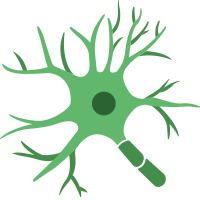
Neural Cell News
Neural Cell News is an online resource covering the latest research in neuroscience, neural stem cells, and neurological conditions.
Reversal of C9orf72 Mutation-Induced Transcriptional Dysregulation and Pathology in Cultured Human Neurons by Allele-Specific Excision
[Proceedings Of The National Academy Of Sciences Of The United States Of America] Investigators generated five different genomic excisions at the C9orf72 locus in a patient-derived iPSC line and a non-diseased wild-type line, and examined gene expression and pathological hallmarks of C9 frontotemporal dementia/ALS in motor neurons differentiated from these lines.
Nose-to-Brain Selective Drug Delivery to Glioma via Ferritin-Based Nanovectors Reduces Tumor Growth and Improves Survival Rate
[Cell Death & Disease] The authors demonstrated that a nanocarrier, named The-0504, could cross the blood-brain barrier and specifically deliver the payload to gliomas that express high amounts of the ferritin/transferrin receptor TfR1 (CD71).
The Autism Susceptibility Kinase, TAOK2, Phosphorylates eEF2 and Modulates Translation
[Science Advances] Scientists used proteomics, genetics, and translation assays in cultured cells and mouse brains to reveal altered translation mediated by loss of the kinase TAOK2 in 16p11.2 deletion models.
Rebound Growth of BRAF Mutant Pediatric Glioma Cells after MAPKi Withdrawal is Associated with MAPK Reactivation and Secretion of Microglia-Recruiting Cytokines
[Journal Of Neuro-Oncology] Four patient-derived pediatric glioma models were investigated to model rebound growth in vitro based on viable cell counts in response to mitogen-activated protein kinase (MAPK) inhibitor (MAPKi) treatment and withdrawal.
An Improved Method for Generating Human Spinal Cord Neural Stem Cells
[Experimental Neurology] Scientists reported further optimization of methods for deriving and sustaining cultures of human spinal cord neural stem cell lines that resulted in improved karyotypic stability while retaining anatomical efficacy in vivo.
Microglial P2Y6 Calcium Signaling Promotes Phagocytosis and Shapes Neuroimmune Responses in Epileptogenesis
[Neuron] Researchers demonstrated that P2Y6 signaling impacted multiple aspects of myeloid cell immune function during epileptogenesis.
GUCY2C Signaling Limits Dopaminergic Neuron Vulnerability to Toxic Insults
[npj Parkinson's Disease] Scientists uncovered a previously unexpected role for the guanylyl cyclase C (GUCY2C)-cyclic guanosine monophosphate signaling axis in controlling mitochondrial dysfunction and toxicity in substantia nigra pars compacta dopaminergic neurons.
NF1 Mutation-Driven Neuronal Hyperexcitability Sets a Threshold for Tumorigenesis and Therapeutic Targeting of Murine Optic Glioma
[Neuro-Oncology] Using mouse models of neurofibromatosis type 1 (NF1)-associated optic pathway glioma (OPG), the authors demonstrated that Nf1 mutation induced neuronal hyperexcitability and midkine expression, which activated an immune axis to support tumor growth, such that high-dose lamotrigine treatment reduced Nf1-OPG proliferation.
Neurofilaments as Biomarkers in Neurological Disorders — towards Clinical Application
[Nature Reviews Neurology] The authors summarize potential clinical applications of neurofilaments as a biomarker of neuro-axonal damage in a range of neurological disorders, including MS, Alzheimer's disease, frontotemporal dementia, ALS, traumatic brain injury, and Parkinson's disease.
AviadoBio Announces First Patient Treated in ASPIRE-FTD Clinical Trial Evaluating AVB-101 for Frontotemporal Dementia with GRN Mutations
[AviadoBio] AviadoBio announced that the first patient has been treated in the Phase I/II ASPIRE-FTD trial evaluating AviadoBio’s investigational gene therapy, AVB-101, in people with frontotemporal dementia with progranulin gene mutations.
Therapeutic Role of PTEN in Tissue Regeneration for Management of Neurological Disorders: Stem Cell Behaviors to an In-Depth Review
[Cell Death & Disease] The authors provide a comprehensive overview of the mechanisms by which phosphatase and tensin homolog deleted on chromosome 10 (PTEN) regulates activities of different stem cell populations and influences neurological disorders, encompassing autism, stroke, spinal cord injury, traumatic brain injury, Alzheimer’s disease, and Parkinson’s disease.
Glutamatergic Neuronal Activity Regulates Angiogenesis and Blood-Retinal Barrier Maturation via Norrin/β-Catenin Signaling
[Neuron] Using in vivo genetic studies in mice, scRNA-seq, and functional validation, researchers showed that deep plexus angiogenesis and paracellular blood-retinal barrier maturation were delayed in Vglut1−/− retinas where neurons failed to release glutamate.
Neural Cell News helps scientists keep pace with the latest research, reviews, and industry developments in neuroscience. Specific research topics include neural development and neuroregeneration, neural signaling related to cellular responses and behavior, and synaptic plasticity. Research into the diagnosis, progression, cellular characteristics, and treatment of brain diseases such as Parkinson’s, Multiple Sclerosis, Alzheimer’s, Amyotrophic Lateral Sclerosis and various brain cancers, as well as brain damage resulting from infection, trauma, stroke, seizures, and tumors, is also covered.

 Cancer Stem Cell News
Cancer Stem Cell News Cell Therapy News
Cell Therapy News Dermal Cell News
Dermal Cell News Endothelial Cell News
Endothelial Cell News ESC & iPSC News
ESC & iPSC News Extracellular Matrix News
Extracellular Matrix News Hematopoiesis News
Hematopoiesis News Hepatic Cell News
Hepatic Cell News Human Immunology News
Human Immunology News Immune Regulation News
Immune Regulation News
 Intestinal Cell News
Intestinal Cell News Mammary Cell News
Mammary Cell News Mesenchymal Cell News
Mesenchymal Cell News Muscle Cell News
Muscle Cell News Neural Cell News
Neural Cell News Organoid News
Organoid News Pancreatic Cell News
Pancreatic Cell News Prostate Cell News
Prostate Cell News Pulmonary Cell News
Pulmonary Cell News
